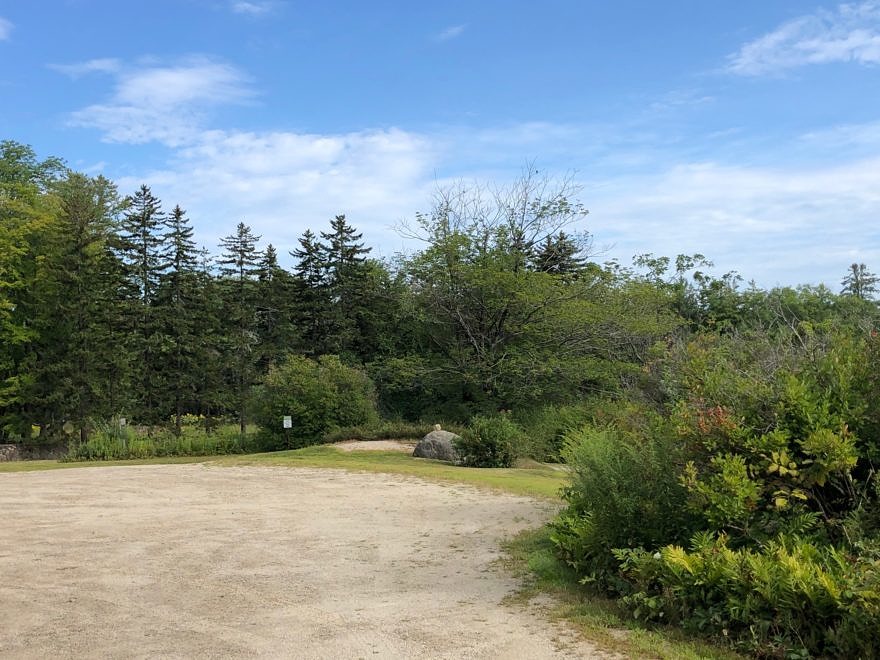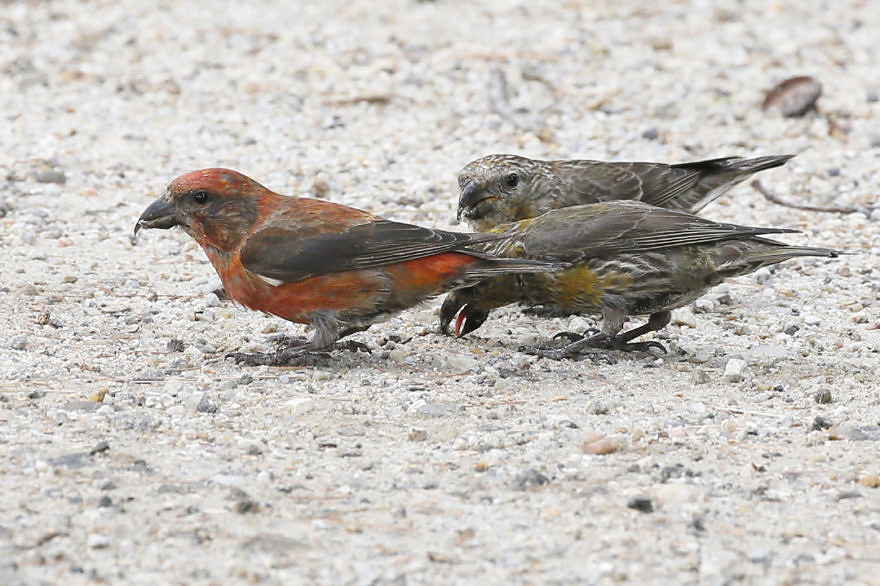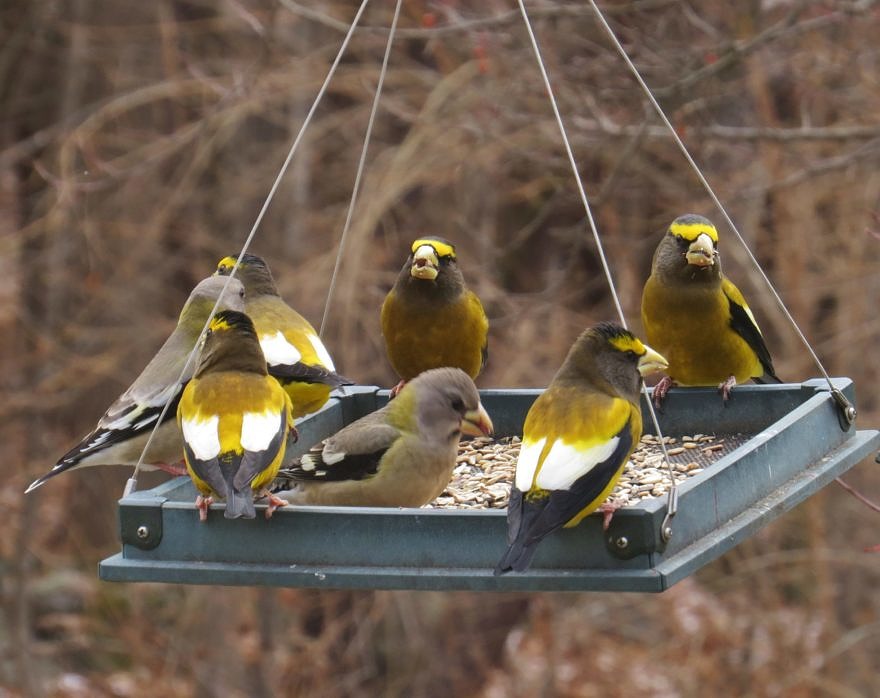Red Crossbill Intrigue in the Harris Center Parking Lot
Editor’s Note: In any given year, boreal finches like crossbills and grosbeaks might stay in the north for the winter, or they might migrate south in a sporadic migration known as an “irruption.” Irruption is a consequence of food availability: if northern spruce, pine, birch, and other tree species produce bumper crops of seeds, there’s no need for the seed-eating birds to leave the boreal forest. If cone crops are poor, finches may wander south in search of sustenance.
This is a banner year to see irruptive winter finches and a bonanza of one of those species, Red Crossbills, found its way to the Harris Center in late summer. Interestingly, Red Crossbills can be grouped by their flight calls as to “call types.” There are 10 call types found across North America, each having its own distinct sound, ecological niche, and core areas of occurrence. An analysis of the recordings I made of the calls of the Harris Center crossbills revealed that there were four different call types, with some of those birds coming from as far away as the Pacific Northwest.
The intrigue started in early August, when Meade Cadot noticed Red Crossbills — large finches with crossed bills that allow them to extract conifer seeds, even from closed cones — coming down into the Harris Center parking lot each morning to pick up grit. Don and myself soon joined Meade (observing the birds from our cars) and, over the course of the next month, witnessed the Red Crossbill numbers grow. Their numbers peaked in mid-to-late August, reaching as many as 40 birds! The group consisted of reddish males, yellowish females, and brownish immatures who would come in bunches, then disperse in different directions by late morning. They would call frequently while flying or sitting in a tree, giving their “jip-jip” call note. Seeing the large number of Red Crossbills was a very special experience and raised many questions, such as: why at the Harris Center, why now, where did they come from, and where are they going?
A Crossbill’s Wish List: Grit, Cones, and the Magic Maple
Although Red Crossbills were being seen throughout the region, the Harris Center especially checked all the boxes on a Red Crossbill’s wish list. First and foremost, there was a quiet parking lot (little used because of the pandemic) full of plentiful grit, just what crossbills need to help process the conifer seeds they eat. Then there was what Meade and we called the “magic maple” — the low, isolated red maple with a top of dead branches at the edge of the parking lot, where the crossbills could land, overlook the scene, preen, and clean their bills. By the way, that tree was not only magic for the crossbills. We recorded at least 30 other species using that maple, including Yellow and Black-billed Cuckoos and Olive-sided Flycatchers, so preserve that tree!

At least 30 bird species were observed preening, perching, or feeding in the dead upper branches of the “magic maple” at the edge of the Harris Center parking lot — a testament to the importance of dead and dying trees as wildlife habitat. (photo © Lillian Stokes)
Red Crossbill feeding habitat also ringed the surrounding area with a bumper crop of white pine cones, as well as some red spruce. While we infrequently saw the crossbills feeding right on those trees, they undoubtedly fed on the plentiful white pine cone crop — and maybe spruces in the region, as well — after their morning gritting sessions. By early September, we noticed that the number of Red Crossbills coming to the Harris Center had dropped off. By the end of September, they were gone, although some were still being seen in smaller numbers in other parts of the Monadnock Region. What happened in September? The white pines began opening and dropping their cones and dispersing seeds.

Three Red Crossbills (one male and two immatures) pick up grit in the Harris Center parking lot in August 2020. Swallowing grit helps them to digest conifer seeds. (photo © Lillian Stokes)
Crossbill Call Types
Red Crossbills have 10 different “call types,” each distinguished by its flight call. There is usually an association between call type and certain conifer species in a core zone of occurrence. These call types do not fit well with the usual concepts of “species” or “subspecies,” and this is being studied. Recently, one of the call types, Type 9, has been elevated to the status of a new species, the Cassia Crossbill, which is sedentary in the South Hills and Albion Mountains of Idaho. Accurately assigning a call type can be done through audiospectrographic analysis of a recorded Red Crossbill call (not song). The analysis is best done by an expert. The average birder cannot discern it by hearing it in the field.
On twelve occasions, I recorded the calls of the Harris Center Red Crossbills with my iPhone app, ShurePlus MOTIV Audio, then sent the recordings in with my eBird checklists and had the call types confirmed by Red Crossbill expert and founder of the Finch Research Network, Matt Young. It turned out that the Harris Center birds were four different call types: Type 1, 2, 3 and 10.
Type 1 are found primarily in the Appalachians from southern New York to Georgia and Alabama and occasionally in the Adirondack Mountains, northern New York, New England, southern Ontario, the Maritimes, and perhaps the Great Lakes. They are rare in the West.
Type 2 are found in the Ponderosa pine forests of the West, but are moderately irruptive and can sometimes be found anywhere.
Type 3 are found mostly in Western hemlock habitat of northern coastal areas of western North America, but can sometimes be highly irruptive into the Great Lakes, the Northeast, Ontario, and the Maritimes.
Type 10, which were most of the Harris Center crossbills I recorded, are thought to be most abundant in northern California to central Oregon, in the Sitka spruce belt found in the outer coastal forest. However, Type 10 also regularly occur and breed in the Northeast year after year, and further study might prove them to be different. Matt and his team at the Finch Research Network are studying this topic as I write.

A juvenile Red Crossbill perched on a dead branch. (photo © Lillian Stokes)
Why Now? Why Here?
Why do Red Crossbills irrupt and what would make at least some of them come here all the way from the Pacific Northwest? Think of Red Crossbills as nomadic birds who can move if their food source runs out in one area and switch to eating different types of conifers that may be abundant in a new area. Red Crossbills can also breed at any time wherever they find ample food, although they mostly breed in late summer through early fall and late winter through early spring. Birds of a certain call type appear to mate with birds of their own call type, but this needs further study.
A likely scenario as to why crossbills are here in abundance across much of the Northeast, according to Matt Young, “is that Red Crossbills in other ‘sprucy’ areas to the north in the Maritimes, Maine, Algonquin Provincial Park in Ontario, northern New Hampshire and Vermont, and Adirondack [Mountains] of New York, had a good breeding season this past year. By spring their [spruce] cone supply had been diminished, though, so they irrupted . . . southward to take advantage of the bumper white pine cone crop found in the more southerly areas of the region. That white pine crop is now getting depleted, so Red Crossbills are on the move again, and are again shifting southward to Cape Cod, Long Island, Pennsylvania, and New Jersey looking for their next good food source. Perhaps they will turn to other conifers like Norway spruce in town villages, Japanese black pine along the dunes of Cape Cod and Long Island, and pitch pine and red pine.”
They also may show up at bird feeders, so watch for them during the Christmas Bird Count, along with other winter finches! Large numbers of Pine Siskins have been seen, and it is turning out to be another big Evening Grosbeak year. Common Redpolls are also irrupting this winter in their biggest movement south in a decade. You may also see other irruptive finches like Pine Grosbeaks and White-winged Crossbills.

Evening Grosbeaks descend on a platform bird feeder in Hancock in November 2020. (photo © Meade Cadot)
Finch Research Network
If you love finches and want to participate in citizen science or more focused finch research, go to the new Finch Research Network (finchnetwork.org), which is a community of people that want to be involved in observing and studying finches. The Finch Research Network website contains a wealth of finch information, including links where you can submit your recordings of crossbill calls. The flagship project is on Red Crossbills. You can also contact Matt Young by email if you have other questions about finches, and don’t forget to submit your finch sightings to eBird. Happy finch watching!

